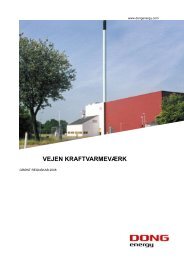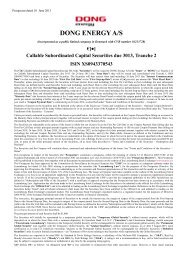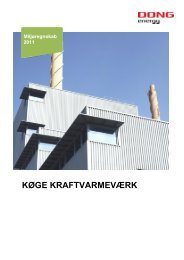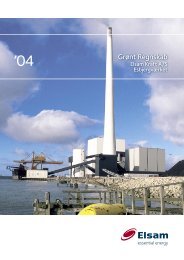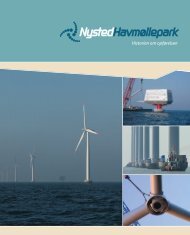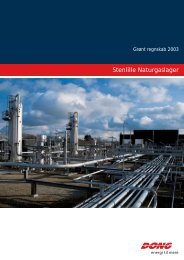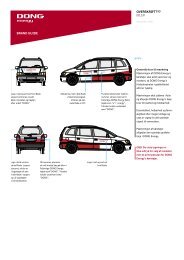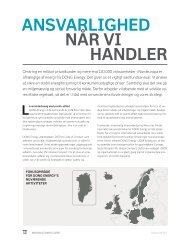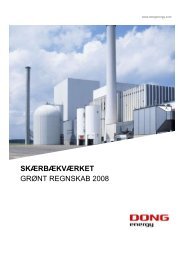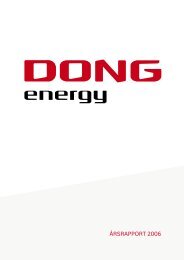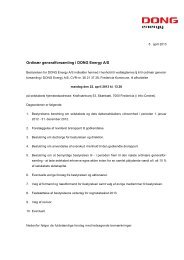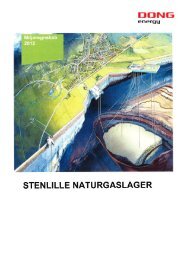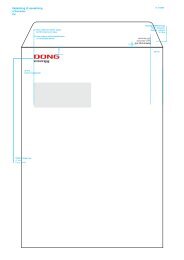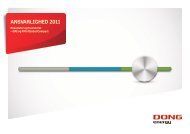ANNUAL REPORT 2011 - DONG Energy
ANNUAL REPORT 2011 - DONG Energy
ANNUAL REPORT 2011 - DONG Energy
Create successful ePaper yourself
Turn your PDF publications into a flip-book with our unique Google optimized e-Paper software.
significant environmental incidents<br />
The impact and materiality of environmental incidents are<br />
evaluated on the basis of a corporate procedure for impact<br />
analysis in connection with environmental incidents. An<br />
environmental incident is an adverse event that has a<br />
negative environmental impact. Only incidents with an<br />
actual environmental impact are reported. Incidents are<br />
only determined for <strong>DONG</strong> <strong>Energy</strong>-operated facilities and<br />
operating activities. Incidents have not been determined<br />
for facilities not operated by <strong>DONG</strong> <strong>Energy</strong> or for projects.<br />
labour<br />
Labour comprises employee data and safety data in the<br />
form of occupational injuries.<br />
Employees<br />
Employees working under contract in Danish and foreign<br />
<strong>DONG</strong> <strong>Energy</strong> companies are included in the reporting, but<br />
not employees of associates. Employee data are recognised<br />
based on records from the Group’s ordinary registration<br />
systems. The number of employees, including by gender<br />
and country, is determined as the number of employees at<br />
the end of the financial year converted to full-time equivalents<br />
(FTE).<br />
Employee turnover is calculated as the number of employees<br />
that have left the company relative to the average<br />
number of employees at the end of the financial year. The<br />
average number of employees is determined as a weighted<br />
average of recorded employees during the year.<br />
Average age has been measured as the average age of employees<br />
at the end of the financial year.<br />
Occupational injuries<br />
Occupational injuries and lost time injuries for own employees<br />
and suppliers are included for companies that are<br />
wholly or partly owned by <strong>DONG</strong> <strong>Energy</strong> and where <strong>DONG</strong><br />
<strong>Energy</strong> is directly responsible for safety. <strong>Energy</strong> Markets<br />
only reports data for its own employees.<br />
Data are recognised for own employees and for suppliers<br />
working in or providing services in areas in which <strong>DONG</strong><br />
<strong>Energy</strong> is directly responsible for safety in its capacity of<br />
operator or because of the operating assignment. Data<br />
from Danish and some foreign sites are recognised. The<br />
criteria for the recognition of suppliers vary for the individual<br />
business areas and over time.<br />
An occupational injury is defined as an injury that results<br />
in incapacity for work of one or more calendar days in addition<br />
to the day of the incident. Fatalities are included.<br />
The injury frequency is calculated as the injury frequency<br />
per one million hours worked. Working hours are based<br />
on 1,667 working hours annually per full time equivalent<br />
(FTE) and monthly records of the number of employees<br />
converted to FTE. For suppliers the actual number of hours<br />
worked is recognised on the basis of data provided by the<br />
supplier, access control systems at locations or estimates.<br />
The injury frequency, and the development of the injury<br />
frequency, is subject to some uncertainty as a result of the<br />
data basis for hours worked and varying criteria for recognition<br />
of suppliers.<br />
<strong>DONG</strong> ENERGY <strong>ANNUAL</strong> <strong>REPORT</strong> <strong>2011</strong> – COnsOliDatED nOn-finanCial statEmEnts<br />
155



